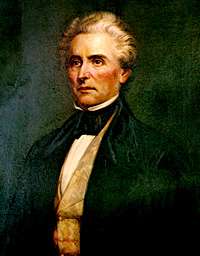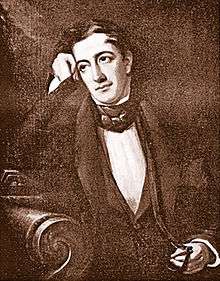United States House of Representatives elections, 1846
| | |||||||||||||||||||||||||||||||||||||||||||
| |||||||||||||||||||||||||||||||||||||||||||
| |||||||||||||||||||||||||||||||||||||||||||
| |||||||||||||||||||||||||||||||||||||||||||
Elections to the United States House of Representatives for the 30th Congress were held at different dates in the various states, from August 2, 1846 (Missouri) to November 2, 1847 (Mississippi and Louisiana). The Whigs picked up 37 seats to win 116 seats, while the rival Democrats lost 30 and fell to 112 seats[Note 3] in the House. The result was a switch of partisan control of the House, with the Whigs gaining a narrow majority of just four seats. The Whigs picked up seats in New England and the South. The nativist American Party, dedicated to opposition to immigration and anti-Catholicism, lost five of its Representatives and was left with only a single seat. In addition, one Independent, Amos Tuck, was elected to New Hampshire's 1st District.
The Mexican–American War was the biggest issue of concern during this election. While the war was widely supported west of the Appalachian Mountains, many people in eastern urban regions were opposed. The extreme loyalty of the Democratic Congress—with only 14 representatives voting against the war—was a huge factor in the Whig pick-up. Growing divisions over slavery were also a contentious concern, as this ever-present issue had been brought to the forefront by Congressional rejection of the Wilmot Proviso.
Notable freshmen include future president Abraham Lincoln, elected as a Whig to his first and only term in this election.
Election summaries
The remaining multi-member at-large districts were abolished for this election, leaving all states with two or more Representatives divided into districts. In 1845, Congress had passed a law establishing a uniform date throughout the Union for choosing electors. The law did not apply to Congressional elections, but the date was gradually adopted for Congressional elections as well. In 1846, only three states (Michigan, New Jersey, and New York) used that date (November 3, 1846).
Two seats were added for the new State of Wisconsin.[1] Wisconsin was unrepresented for most of the 1st session.
| 116 | 1 | 1 | 112 |
| Whig | I | AKN | Democratic |
| State | Type | Date | Total seats |
Whig | Democratic | Other | |||
|---|---|---|---|---|---|---|---|---|---|
| Seats | Change | Seats | Change | Seats | Change | ||||
| Michigan | District | November 3, 1846 (Election Day) |
3 | 0 | 3 | 0 | |||
| New Jersey | District | 5 | 4 | 1 | 0 | ||||
| New York | District | 34 | 23 | 11[Note 4] | 0 | ||||
| Arkansas | At-large | August 3, 1846 | 1 | 0 | 1 | 0 | |||
| Delaware | At-large | November 10, 1846 | 1 | 1 | 0 | 0 | |||
| Florida | At-large | October 5, 1846 | 1 | 1 | 0 | 0 | |||
| Georgia | District | October 5, 1846 | 8 | 4 | 4 | 0 | |||
| Illinois | District | August 3, 1846 | 7 | 1 | 6[Note 5] | 0 | |||
| Maine | District | September 14, 1846 | 7 | 1 | 6 | 0 | |||
| Massachusetts | District | November 9, 1846 | 10 | 10 | 0 | 0 | |||
| Missouri | District[Note 6] | August 2, 1846 | 5 | 0 | 5 | 0 | |||
| Ohio | District | October 13, 1846 | 21 | 11 | 10 | 0 | |||
| Pennsylvania | District | October 13, 1846 | 24 | 16 | 7 | 1[Note 7] | |||
| South Carolina | District | October 12–13, 1846 | 7 | 0 | 7 | 0 | |||
| Texas | District | November 2, 1846 | 2 | 0 | 2 | 0 | |||
| Vermont | District | September 1, 1846 | 4 | 3 | 1 | 0 | |||
| 1847 elections | |||||||||
| Alabama | District | August 2, 1847 | 7 | 2 | 5 | 0 | |||
| Connecticut | District | April 5, 1847 | 4 | 4 | 0 | 0 | |||
| Indiana | District | August 2, 1847 | 10 | 4 | 6 | 0 | |||
| Iowa | District[Note 6] | August 2, 1847 | 2 | 0 | 2 | 0 | |||
| Kentucky | District | August 2, 1847 | 10 | 6 | 4 | 0 | |||
| Louisiana | District | November 2, 1847 | 4 | 1 | 3 | 0 | |||
| Maryland | District | October 6, 1847 | 6 | 4 | 2 | 0 | |||
| Mississippi | District[Note 6] | November 1–2, 1847 | 4 | 1 | 3 | 0 | |||
| New Hampshire | District[Note 6] | March 9, 1847 | 4[Note 8] | 1 | 2 | 1[Note 9] | |||
| North Carolina | District | August 5, 1847 | 9 | 6 | 3 | 0 | |||
| Rhode Island | District | April 7, 1847 | 2 | 1 | 1 | 0 | |||
| Tennessee | District | August 2. 1847 | 11 | 5 | 6 | 0 | |||
| Virginia | District | April 22, 1847 | 15 | 6 | 9 | 0 | |||
| 1848 elections | |||||||||
| Wisconsin[Note 10] | District | May 8, 1848 | 2 | 0 | 2 | 0 | |||
| Total[Note 2] | 230 | 116 50.4% |
|
112[Note 3] 48.7% |
|
2 0.9% |
| ||
Complete returns
Florida
| District | Incumbent | Party | First elected |
Result | Candidates |
|---|---|---|---|---|---|
| Florida at-large | William H. Brockenbrough | Democratic | 1845 (special) | Retired Whig gain |
Edward C. Cabell (W) 50.9% William A. Kain (D) 49.1% |
See also
- List of United States House of Representatives elections, 1824–54
- United States Senate elections, 1846
- 30th United States Congress
Notes
- ↑ Excludes states admitted during the 30th Congress.
- 1 2 3 Includes late elections
- 1 2 3 Includes 2 Independent Democrats elected to IL-01 and NY-17 – see: Martis, p. 100-101.
- ↑ Includes George Petrie, who was elected to NY-17 as an Independent Democrat.
- ↑ Includes Robert Smith, who was elected to IL-01 as an Independent Democrat.
- 1 2 3 4 Changed from at-large
- ↑ 1 Know-Nothing
- ↑ One seat had been vacant during the entire 29th Congress.
- ↑ Amos Tuck was elected to NH-01 as an Independent.
- ↑ New state
References
Bibliography
- Dubin, Michael J. (March 1, 1998). United States Congressional Elections, 1788-1997: The Official Results of the Elections of the 1st Through 105th Congresses. McFarland and Company. ISBN 978-0786402830.
- Martis, Kenneth C. (January 1, 1989). The Historical Atlas of Political Parties in the United States Congress, 1789-1989. Macmillan Publishing Company. ISBN 978-0029201701.
- Moore, John L., ed. (1994). Congressional Quarterly's Guide to U.S. Elections (Third ed.). Congressional Quarterly Inc. ISBN 978-0871879967.
- "Party Divisions of the House of Representatives* 1789–Present". Office of the Historian, House of United States House of Representatives. Retrieved January 21, 2015.
External links
- Office of the Historian (Office of Art & Archives, Office of the Clerk, U.S. House of Representatives)
| ||||||||||||||


